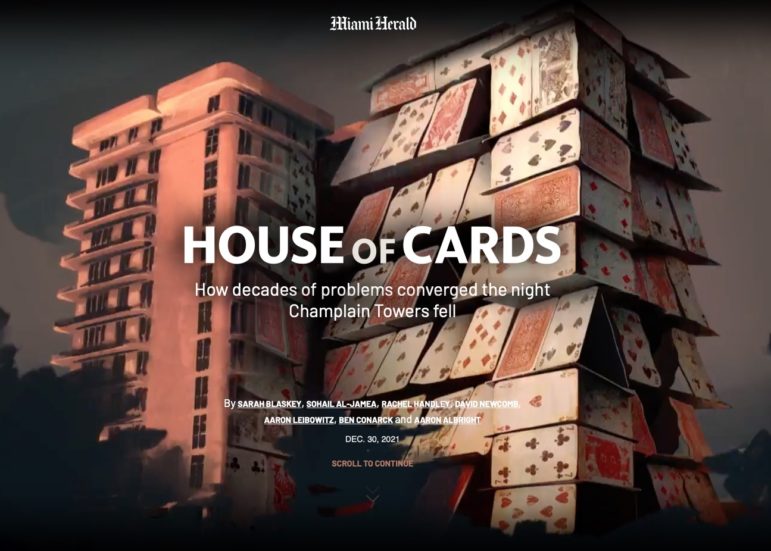
The Miami Herald’s scrollytelling investigation, House of Cards, offers intricate, chronological details of a condominium’s deadly collapse. Image: Screenshot
In June, the story featured below was recognized with the International News Media Association’s Global Best in Show award. “The Miami Herald’s House of Cards entry is a meticulous journalistic investigation of the Champlain Towers South collapse and the multimedia representation of the investigation, which involved witness testimonials of the tragedy, construction experts, and consulting engineers, to dig into the causes of the construction’s weakness,” INMA noted at the ceremony.
A 12-story condo building collapsed in the middle of the night in June of 2021, killing 98 people just down the street from my South Florida home in the US. It was a life-altering event for me and my colleagues at The Miami Herald, where I work as an investigative reporter.
I say that because the beachfront is a kind of close colony, where a lot of us live, and these were our neighbors. And because I was assigned to a team tasked with explaining why a condo that was not extremely old — or under construction or the victim of a natural disaster — pancaked down on itself in the middle of a totally unremarkable night.
Six months of reporting, 10 eyewitnesses, thousands of pages of public records, and a partnership with one of the leading experts on reinforced concrete structures in the US uncovered not just one cause, but a sequence of failures that resulted in one of the deadliest collapses in modern US history.
We published the findings as House of Cards, an interactive narrative that used 2D and 3D animation, along with photos and videos from the collapse to illustrate what happened and explain why the tower fell.
Key Takeaways in Innovative Storytelling
Although some of my observations about our process might seem obvious, I hope that they might be helpful to others engaged in both non-traditional and traditional forms of investigative storytelling. These are my five big takeaways from crafting House of Cards:
- Choosing a scrollytelling format was part of an intentional process, driven by the content more than anything else. Here’s what I mean: Our intention was to enhance our audience’s understanding of the causes behind the collapse, while also helping them understand why such nitty-gritty, technical details were something everyone should care about. At first, we thought we would produce a narrated animation to help people experience what happened. But, about halfway through the process, we realized that, unlike an animated video, scrollytelling allows readers to absorb information at their own pace and, as such, it was a better format for such a complex topic.
- Animated visuals were helpful for explaining directional orientation (i.e. “the north wing”), proximity (like how close someone was to the part of the building that collapsed), and vantage point of eyewitnesses (explaining what they could see, what they couldn’t, and why). In each case, a written explanation would have taken at least a paragraph and still not given the audience the same level of understanding. Visual metaphors were also useful for explaining complex engineering concepts without hundreds of extra words. For example, animated hands holding something up by applying pressure from two sides was probably more effective than just a written explanation of the restraining forces applied by the perimeter wall to the pool deck.
- The foundation of our success was the truly collaborative, interdisciplinary approach we took to investigative reporting. The Herald worked with Dr. Dawn Lehman and her team at the University of Washington, who interpreted building plans, looked through thousands of photos and videos of the collapse, and ultimately used cutting-edge computer modeling techniques to test theories of collapse. Meanwhile, reporters were able to put together timelines and interviews that guided Dr. Lehman’s process and allowed her to refine the model and ultimately come up with a plausible theory of collapse. (You can read more about that here.)
- Every detail mattered in both the animations and the text — from correctly depicting the size and placement of all columns to color choices that reflected reality. (I once had an hour-long discussion with Dr. Lehman about whether “gaping crack” was the appropriate translation of an engineering term for a particular type of spalling.) When House of Cards launched, the peace of mind that came from knowing how carefully it had been constructed was worth all of the sweat, anxiety, and devotion to detail and precision along the way.
- This project took a huge team. Reporters, editors, animators, illustrators, front-end developers, designers, sound engineers, and experts dedicated an extraordinary amount of time and energy to this project. Without each one of them, it wouldn’t have been possible. A special shout-out to my co-producer Sohail Al-Jamea and his team, my editor, Casey Frank, reporting partners Aaron Leibowitz and Ben Conarck, and art director Eduardo Alvarez, who were all on this project with me from day one.
This story was originally published on the International News Media Association (INMA) website. It is reprinted here with permission.
Additional Resources
Turning Dead-Ends Into Breakthroughs Using Visual Investigation Techniques
Useful Visualization Tools for Investigative and Data Journalists
9 Types of Visual Storytelling on Mobile
 Sarah Blaskey is an investigative reporter for the Miami Herald in Florida. She is co-author of the book The Grifter’s Club, which investigated the web of influence linked to former President Donald Trump’s club Mar-a-Lago. She has also worked as a freelance journalist for Reveal and a postgraduate fellow at the Stabile Center for Investigative Reporting at Columbia University.
Sarah Blaskey is an investigative reporter for the Miami Herald in Florida. She is co-author of the book The Grifter’s Club, which investigated the web of influence linked to former President Donald Trump’s club Mar-a-Lago. She has also worked as a freelance journalist for Reveal and a postgraduate fellow at the Stabile Center for Investigative Reporting at Columbia University.

